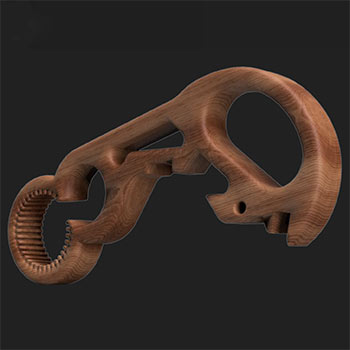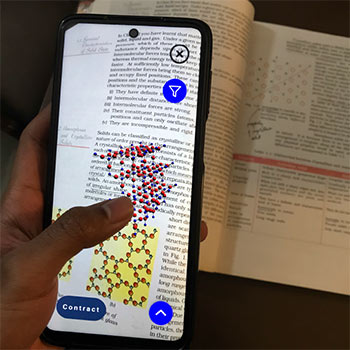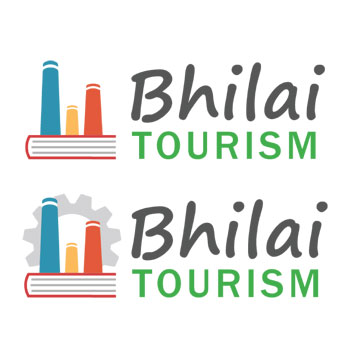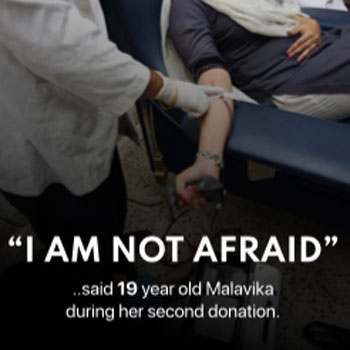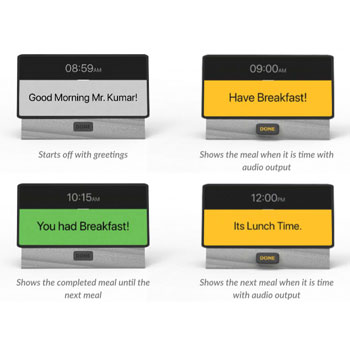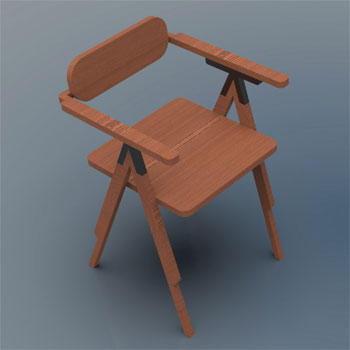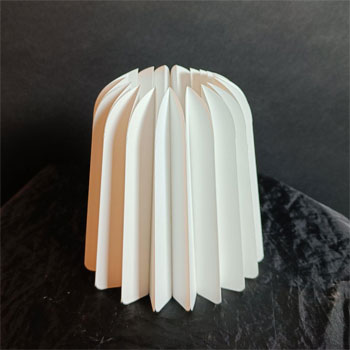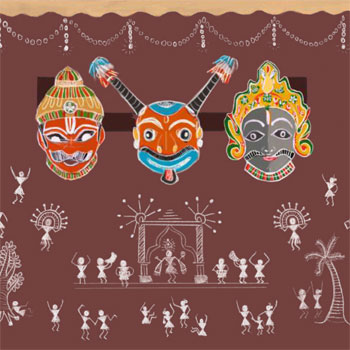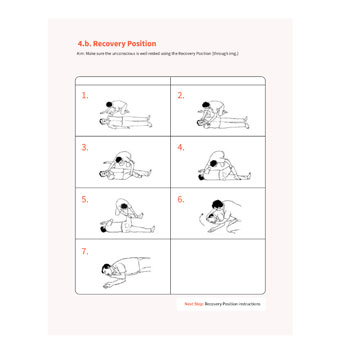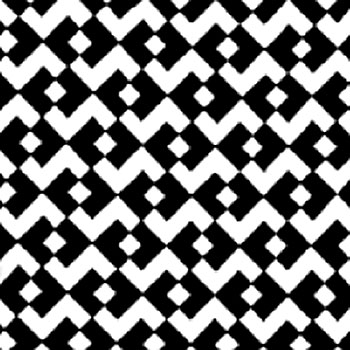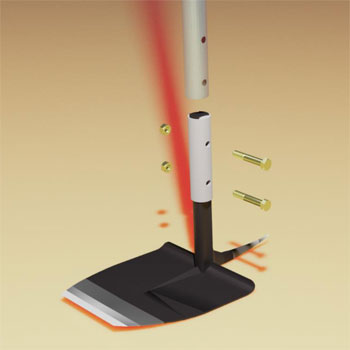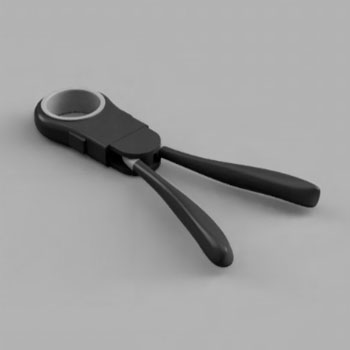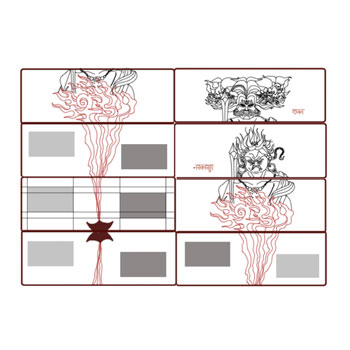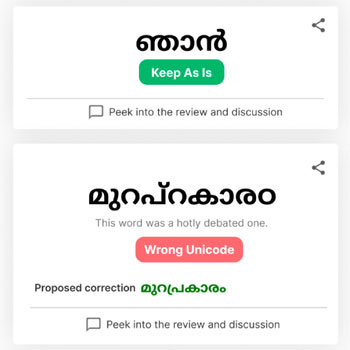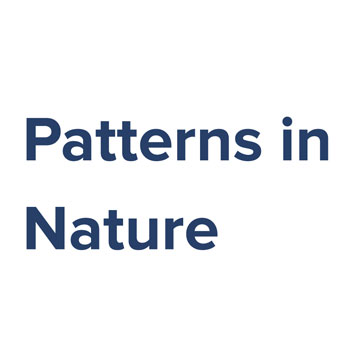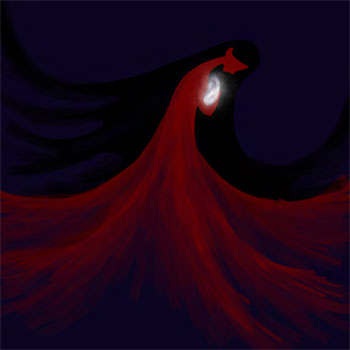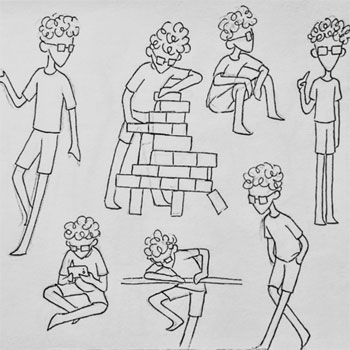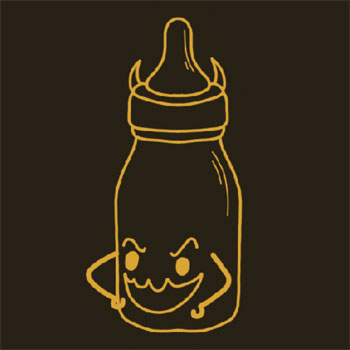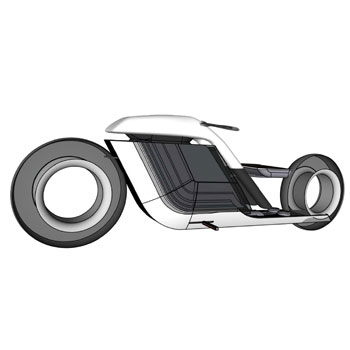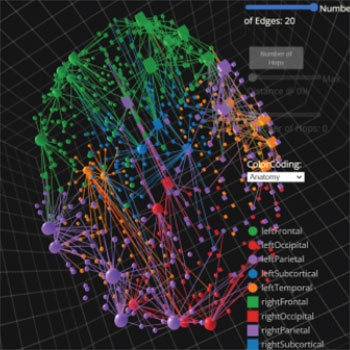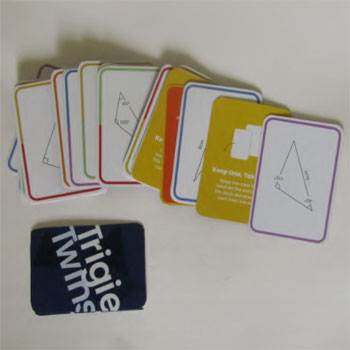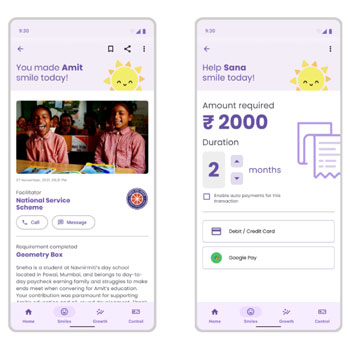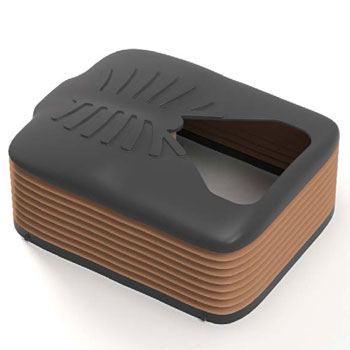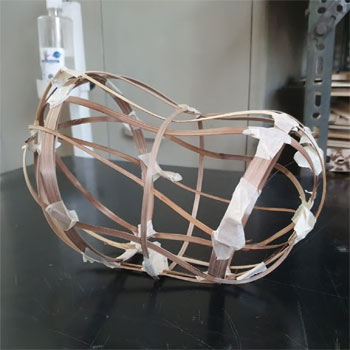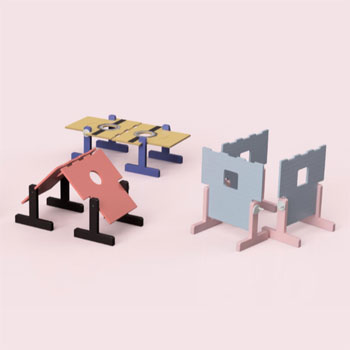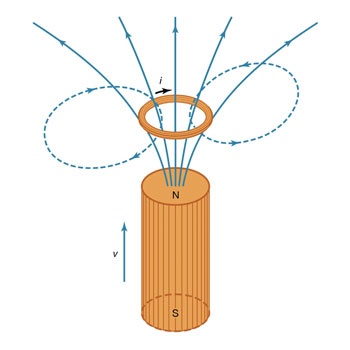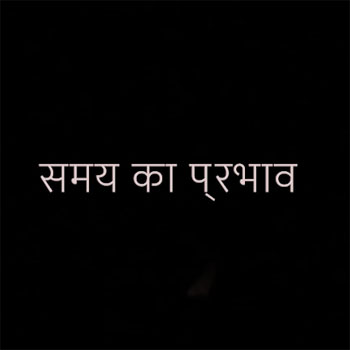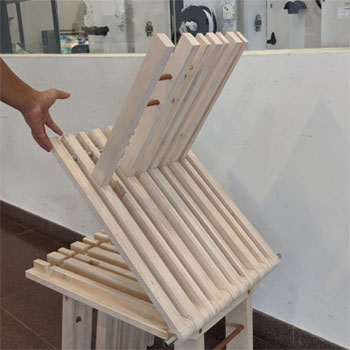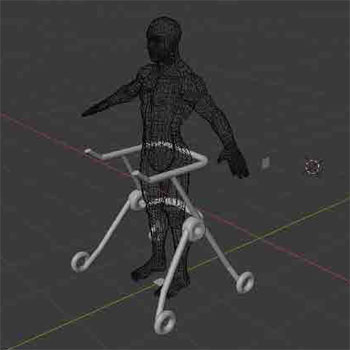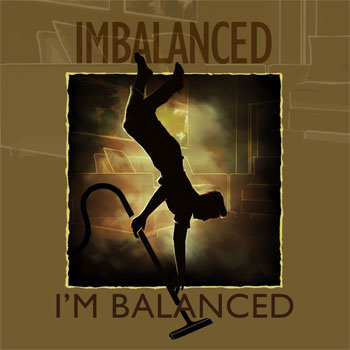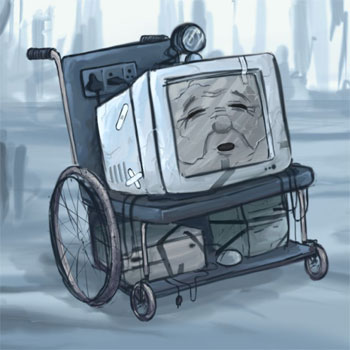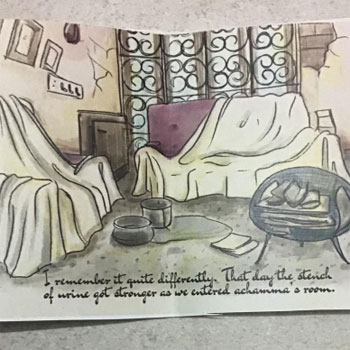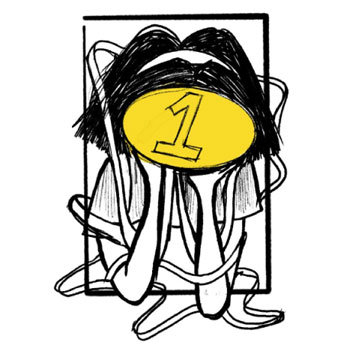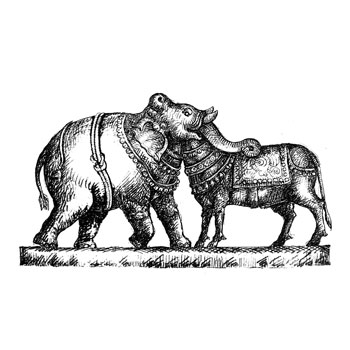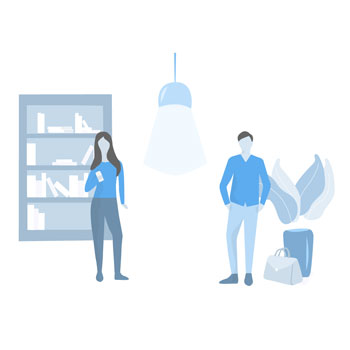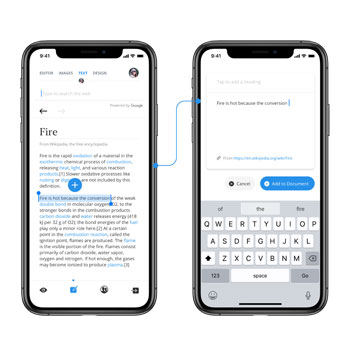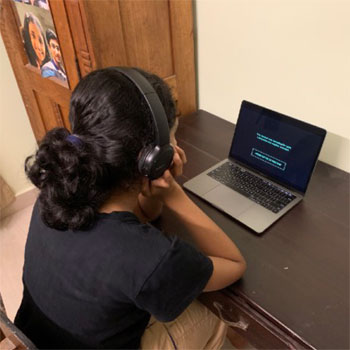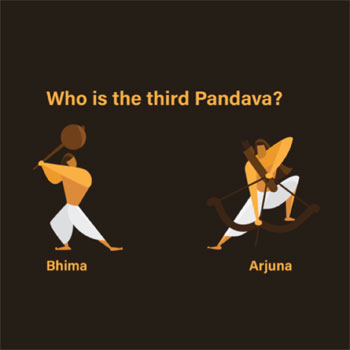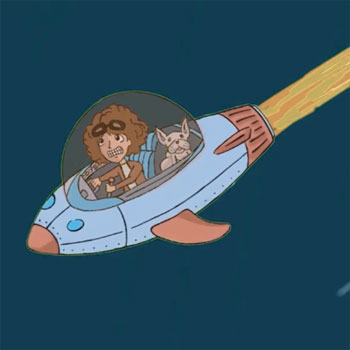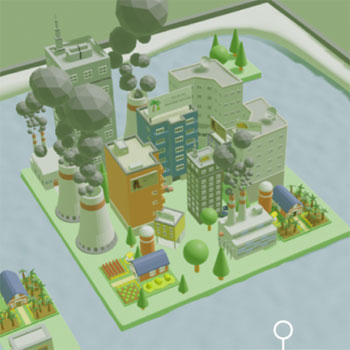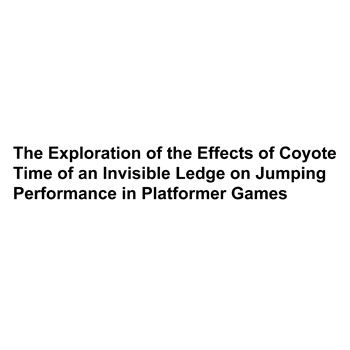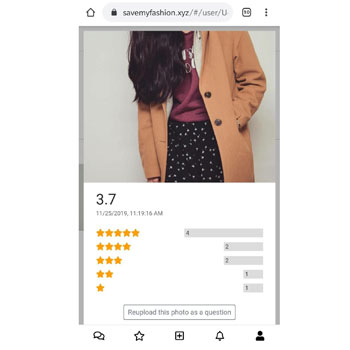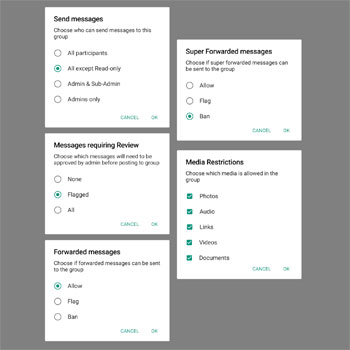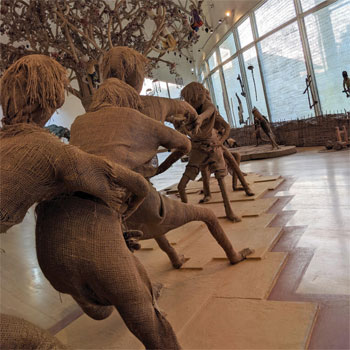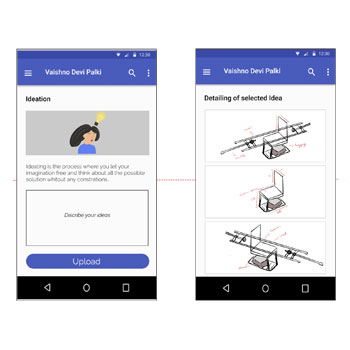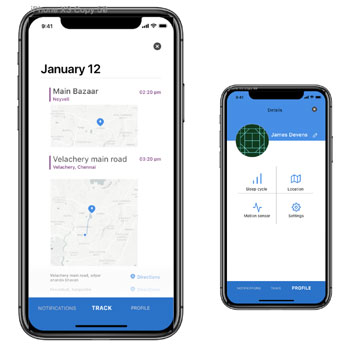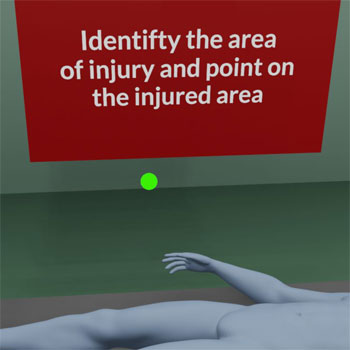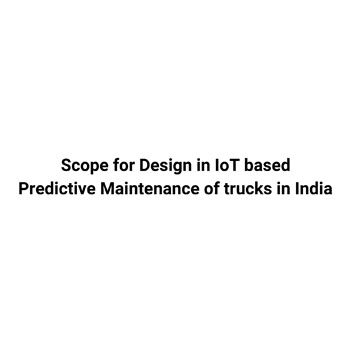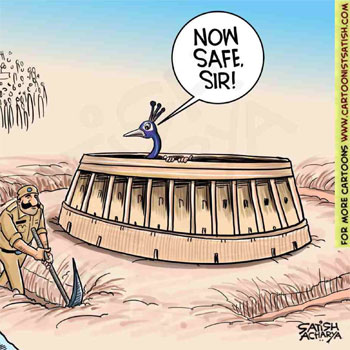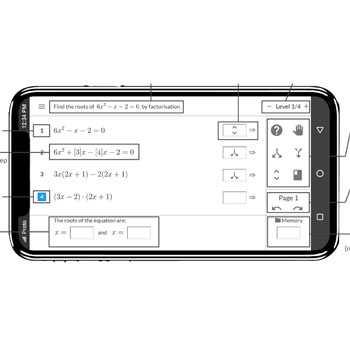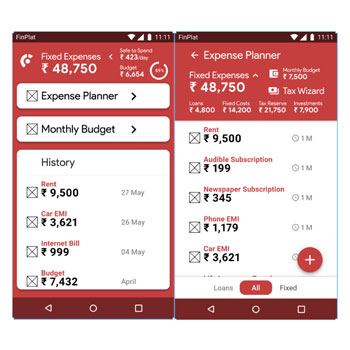B.Des
2019-onwards
(93 items)
Bottle Opener
by Rashi Gupta
by Rashi Gupta
A bottle opener is the device that enables the removal of metal bottle caps (crown caps) from glass bottles. More generally, it might include corkscrews used to remove cork or plastic stoppers from wine bottles or can openers. The brief was to create a universal opener, thus the product is to be used single-handedly. Additional features like can opener and water bottle openers were added to make it more functional.
Details >>Accessibility solution for wheelchair users for the bus transit system in Israel
by Tarun Mugunthan
by Tarun Mugunthan
The project was done as part of a course I did at Holon Institute of Technology(HIT, Israel). It was a group project where my role was to design the solution which would be followed up with prototyping/deployment by the rest of my team mates who were engineering students. The duration of the project was 2 months with weekly progress meetings in between. The brief given to us was broad; to give a proposition to improve quality of life of citizens of Tel Aviv in a defined context and provide a completely detailed out solution with a prototype. We had freedom to choose any context we wished to work with. Through brainstorming, we came up with several ideas out of which we picked the idea of improving wheelchair user experience and accessibility of the public bus transit system in Israel.
Details >>Augmented Reality In Education
by Aaditya Aji
by Aaditya Aji
Formal education acts as stepping stones for creating a learning environment for students throughout the high school and college journey. During the COVID pandemic, the schools had to be closed down and students were stuck at home with their classes happening virtually through online video conferencing tools and virtual classrooms which naturally affected the learning environment for the students. In conventional classroom environment, the day would consist of several subjects as periods along with extra curricular activities(ECAs) to create a balance, along with competitions, events, workshops, practical laboratory classes etc. which created a good learning environment for students. With the sudden change in the formal education sector, students could not adapt to the new ways of instructional learning which severely affected the performance of the students. The learning environment that the traditional system created was missing from the virtual classroom approach. It was also interesting to note that the education sector was several hit because there wasn’t any significant change that had happened in the sector until recently with several online education platforms coming up in the form of open-source courseware or startups which tutor students. I thought it’d be interesting to explore the possibilities of new tech in the sector the way it has affected other growing sectors such as finance, health, etc. In my project, I’m using AR to aid students in 3D visualisations of concepts explained in class 12th NCERT textbook which could help them understand the concepts better along with other supportive material which will help them develop curiosity and interest in the topics while maintaining a seamless self-learning experience under the pandemic conditions which was earlier fulfilled by the formal education system through various activities and social learning environment in schools. The AR mobile app can be used to scan images in the NCERT textbook which opens a 3D visualisation that the students can interact with, and explore to understand the spatial features, which further allows them to question and gain interest in the area, nudging them to read and know more about the topic. The app also provides additional learning material from Wikipedia, which can be used to read up about the relevant related topics and relevant instructional videos which can help a student understand concepts through instructional means which was missing due to problems faced in the virtual classroom environment, earlier students would interact with teachers and students in classrooms when they faced issues or doubts. This blended learning approach has proven to be more engaging for students and hence this opportunity could be used to develop a framework that can be used to create or curate more educational content. Exploring that possibility and suggesting a solution in the direction was my primary motive of the project.
Details >>Automation in polyhouse
by Pranav Pagar
by Pranav Pagar
Polyhouse is a structure made of translucent material like polyethene, where the plants grow under well-controlled climatic and ideal conditions. Polyhouse is mainly used where the environment for some plants is not ideal. The size of the structure can differ from small house to big-size buildings as per the need. The high-end polyhouses have installed advanced technology like heating and cooling systems, lighting, monitoring screens, and computerized system which provide the ideal conditions for plants. People tending towards polyhouse cultivation is due to more profits and the possibility to grow crops throughout the year without depending on environmental factors.
Details >>Street Sounds
by Akshat D. Hyanki
by Akshat D. Hyanki
People from all around the world travel, work, or do some things daily. These events occur in a variety of locations and are associated with various sounds. The sources of these sounds may be natural, machine-made, or produced by humans. There are many different elements corresponding to the origination of these sounds and how they are produced. In this project, I will document and analyse sounds produced by various sources, which will finally map the sounds during different times.
Details >>Understanding Logo Design
by Akshat D. Hyanki
by Akshat D. Hyanki
A logo is what identifies a company by the use of a symbol, signature, or mark. It doesn’t necessarily have to describe what a business does, but it should represent the story of the brand and company. Logos do not sell the company persay, but over time a logo helps consumers build trust with a company’s products or services. Corporate logos are intended to be the ‘face’ of a company. They are the unique identifier of a company, and through colours, fonts, and images, they provide essential information about a business that allows customers to relate with the company’s core brand. Logos are also a shorthand way of referring to a company in advertising and marketing materials; they provide an anchor point for the various other aspects in a project as well, like fonts, colours, and the design choices. This analogy completely embodies why a strong logo is important. A logo creates an image for your brand, and the more people see your logo, they can start to associate it with your brand. Just like how we associate the “swoosh” logo with Nike, or the “golden arches or M” with McDonalds.
Details >>Local Tourism Promotion
by Akshat D. Hyanki
by Akshat D. Hyanki
Tourism is one of the world’s fastest-growing industries and a major source of foreign exchange earnings and employment for many developing countries. It is vital to many countries well-being because of the income generated by the consumption of goods and services by tourists, the taxes levied on businesses in the tourism industry, and the opportunity for employment and economic advancement by working in the industry. This fundamental is also applicable from city to city.
Details >>Design Strategy to enable more periodic blood donations in India to tackle the current shortage of blood
by Anagha Aneesh
by Anagha Aneesh
India is currently facing a shortage of blood due to the lack of voluntary donors and the lower frequency of periodic donors, as they are concerned about the safety regarding donations after the pandemic. A major fraction of the adult population was found to be unaware of the requirement and the urgency of the situation and often give in to misconceptions leading to no donation. This project aims at understanding how to tackle the high demand and low supply of blood in the country and identify motivations that could aid the situation by studying the common trends and demographics of periodic donors and understanding the level of awareness that people have in this sector. The main objective of the study would be to devise how to bring in more first-time donors and encourage repeated donations to tackle the current shortage of blood in the country. Two types of studies, both qualitative and quantitative, were conducted. The findings from the study were mapped out and overlapped with the findings from existing literature to derive major conclusions.
Details >>Assistive Aid for the Elderly with Early Dementia
by Anagha Aneesh
by Anagha Aneesh
Memory loss is unusual forgetfulness, which is a persistent failure to remember. It results from changes in the brain and can be a normal part of ageing or a symptom of another medical condition or damage. It often goes undiagnosed mainly because people think their memory loss is not a big deal and sometimes because they do not want to be diagnosed as a patient with memory impairment. People with dementia were found to be less cooperative and to exhibit varying levels of confidence, leading to discord in the household. People with dementia face difficulties completing daily tasks and are often left being confused about whether a task is already done or not. They need constant attention from their carers to keep track of their activities, as repetition or skipping a particular activity, for example, taking medicine for blood pressure, may cause a major imbalance in their bodies with adverse effects. In such a case, an assistive aid that could make them more self-reliant, hence taking some of the responsibility off the carer’s shoulders, might make a huge difference in a dementia-caring household. This project aims at developing assistive aids for people falling under the first three stages of dementia to help them get through their daily routine while reducing their level of dependence on their caregivers. This report covers the secondary research on existing alternatives and past projects and primary research conducted on 15 subjects, the results of the research, and a suggested solution.
Details >>Web Experience to enable more Periodic Blood Donations in India to tackle the current shortage of blood
by Anagha Aneesh
by Anagha Aneesh
India is currently experiencing a blood scarcity due to a lack of voluntary donors and a reduction in the frequency of regular donors, who are concerned about the safety of visiting a facility and donating blood following the pandemic. A significant portion of the adult population is unaware of the need and seriousness of the problem and frequently succumbs to misunderstandings, resulting in no donation. By studying the common trends and demographics of periodic donors, as well as the level of awareness that people have in this sector, this project aims to better understand how to address the country's high demand for blood and low supply, as well as identify motivations that could help the situation. The primary objective of the study would be to devise how to bring in more first-time donors and encourage repeated donations to tackle the current shortage of blood in the country. Two types of studies, both qualitative and quantitative, were conducted. The findings from the study were mapped out and overlapped with the findings from existing literature to derive major conclusions. Based on these conclusions, the final output was created, which is a webspace that unifies existing platforms to provide a transparent experience for all user groups while making the general public aware of the necessity and benefits, clearing misconceptions, motivating and guiding the donors, and finally allowing the donation facilities to provide better outreach and experience to the donors. Evaluation criteria were also devised and planned for the future.
Details >>Designing a Retro Indian Office Chair
by Arjun Abhilash
by Arjun Abhilash
For my P1, I decided to make a chair. For this, I started out looking at a wide range of iconic chairs, and after discussing with my guide, I selected the Indian office chair by Piere Jeanneret. The project was to redesign this chair to make it modern. I researched a lot about the history and heritage of the chair. I also looked into different kinds of wood and joineries. I also did my parallel product study, which was mainly newer versions of the chair made by passionate studios. For ideating, I started out by exploring and trying a wide range of ideas. As I was exploring various concepts for the final design, I also started working with wood parallelly and made joineries and dowels so that I would have a better idea when I make the final chair. After the final concept was ready, I made a 3D model of the chair and then proceeded to make it out of wood.
Details >>Elderly friendly chair- Furniture design
by Arjun Abhilash
by Arjun Abhilash
For project 2, I decided to work on furniture for the elderly. After discussion with my guide, the project evolved into Chairs for the elderly. For this, I took interviews of the elderly and also did my share of secondary research. After I did my primary and secondary research, I got a lot of insights. This helped me to come up with my brief: design a chair for the elderly, which is very easy to get in and out of and is also very comfortable. Then I proceeded to do ideation, and from the ideation came the concepts. Then I made mockups of the concepts, and the final design of the chair was also ready. Then I made a full-size working rig to test.
Details >>Designing plastic lamp shades- Material design and exploration
by Avinash Manikandan
by Avinash Manikandan
Through the course of my college education, I have gotten disconnected from fiddling with forms and products. The design exploration project seemed like the perfect opportunity to revisit and satisfy my interest in this field. Amongst all the available options for material design, designing lamps and lighting fixtures was the obvious choice for me, as it offers the most freedom for exploration, with infinite possibilities for shaping light. I wanted to make sure I get the satisfaction of tangible output, and Prof. Sandesh believed in the same, making it an easy decision for me.
Details >>Making a Fictional Short Film- Based on the Book 'Wings of Fire'
by Avinash Manikandan
by Avinash Manikandan
Unlike the “Award Films” in Tamil/Malayalam cinema, my interest lies in telling a good story in a commercially successful way. This project is an attempt to understand the audience and what they appreciate. ‘Wings of Fire,’ the autobiography of Dr. A. P. J. Abdul Kalam, is the book that first came to my mind when I was thinking about what to write for my first fictional short film. There are multiple reasons for this choice, but the most important is the absence of any movie about this great person. The concept of the story is to have gripping, high-stakes walk-and-talk conversations, through which we learn about the strengths and weaknesses, the moral and psychological conflicts, and insights into the protagonist’s personal life, Abdul Kalam. My work as the filmmaker covers roughly the entire process, the three stages of production. I have also adopted the story structure proposed by John Truby in his book ‘The Anatomy of a Story.’
Details >>Nithya'- Co-creating a fictional short film
by Avinash Manikandan
by Avinash Manikandan
‘Nithya’ is a 25-minute fictional short film in Hindi. The film is about Abhimanyu, a 10-year-old boy who dislikes all girls, especially his classmate, "everyone's favourite," Nithya. But the only person he can complain to about this favouritism is his caring and jolly mom, a young divorcee who is under the pressure of having to get remarried. Most student films are experimental, ambitious, slow, and “deep” without a cause. We wanted to make a short film that deliberately stuck to the basics of a simple and dramatic plot—focusing on delivering all the different emotions and energies that actors can bring while trying to ground it in our relatable society. The film is a blend of energy, humour, and silliness, along with hard-hitting emotions, pain, and finally, hope.
Details >>Infographic on Warli Festivals being celebrated by their Community
by Drishti Das
by Drishti Das
The project aims to document, classify, and experiment with information visualisation of cultural events in India. In this project, I focus on how the Warli community of Palghar district celebrates their traditional festivals by depicting traditional Warli paintings on their house walls. I started by revisiting and analysing our old project. With the project aim/motivation in mind, I collected more information about their culture through secondary research and organised the data according to the decided relevant factors for the visualisation, then explored some ideas. The final output communicates the ways these festivals are celebrated in Warli culture by depicting the traditional Warli paintings on the walls of their houses, with people and decorations in the background, mimicking their household during that occasion. It serves as a way of exploring their culture for newbies to lightly get introduced to their culture.
Details >>Vocabulary Memorization Application for Hindi Medium School Students
by Drishti Das
by Drishti Das
The English language plays an important role in today’s world. In most Hindi Medium Schools, English is taught as a second language from classes 5-7. The students are struggling with it given their lack of exposure, motivation, and current sociological conditions. The main aim of the curriculum is to enable students to communicate and understand the language effectively. In order for that to happen, the first step is to learn the script. The second important step is to master the necessary vocabulary words. This project aims at developing a solution that allows Hindi Medium School students from classes 5-7 whose primary language is not English to learn and memorise a certain number of new words over a set period. This report covers the secondary research on existing learning and teaching methods and alternatives currently in use and the primary research conducted on the target users and the English subject, the results of the research, analysis, and a suggested solution.
Details >>Introducing Emergency Response Care into School Education System
by Drishti Das
by Drishti Das
Road traffic accidents (RTAs) are regarded as one of the leading causes of grave injuries and fatalities in the world. How can the common public help out in taking immediate action based on the injuries? The overall aim is to enable the common public with information about emergency response care, particularly the bystander’s role within that, so that they can help out the victim during a road accident. The approach eventually shifted from having an intervention at the accident scene to incorporating it at the school level. The final output was a course design system about the bystander’s role in post-crash care, which included performing practical exercise and mock drills with a road accident situation and procedures to follow after that. It is a hybrid model of theoretical content and hands-on activities. It will be introduced in the school curriculum, with the theory parts taught along with the Road Safety chapter in NCERT. These exercises can be conducted in the classroom itself with the teacher being your guide and a manual with all the information and instructions about Emergency Response Care in Road Accidents.
Details >>Form, Transition and Abstraction
by Jake V. Abraham
by Jake V. Abraham
The purpose of this project is to create an easy-to-grasp video lecture on the topic “Form, Transition, and Abstraction.” The initial intention was to cover a much bigger portion of form, a principle of two-dimensional design. But, to cover the vast knowledge about form requires a considerably longer time and resource than what is available for the project scope. So, the basics of three topics were selected from the available material and condensed into an easy-to-understand material and presented. The lecture explains the basics of form, transition, and abstraction through suitable examples. To test the understanding of the student, easy-to-complete exercises are also provided to
Details >>Story Telling through Motion Comics
by Jake V. Abraham
by Jake V. Abraham
In 2001, Budget Monks, consisting of three guys—an illustrator, a writer, and a technician—created the first ever motion comic, Broken Saints. A motion comic (or animated comic) is a form of animation combining elements of print comic books and animation. Individual panels are expanded into a full shot while sound effects, voice acting, and animation are added to the original artwork. Mostly, motion comics have been used to animate existing comics and in movies and trailers to show flashbacks or memories of a person. This project takes more of a comic book animation rather than an animated comic book approach.
Details >>Agricultural Tool Redesign, Thoomba
by Jake V. Abraham
by Jake V. Abraham
Growing your own crops is a good action from our part. To do this, you need tools. Tools for planting, maintenance, harvesting, and storing it. During one of such harvest processes, I came across a hurdle. We were using a long pole sickle to pluck fruits, and the home-made tool was not enough as the trees were too tall. Increasing the height meant much heavier weight and that was not a suitable solution. This led me to want to create a tool for harvesting fruits irrespective of the tree height. When I started researching about this, I came across an entrepreneur who had the same idea as e and created what I had envisioned and made it much better. This led me to look into other agricultural and farming tools, and the thoomba (a Kerala shovel) caught my eye. We had an assortment of thoombas at my home and nearby houses. All of them happen to be quite old, ranging from 10 to 30 years or older, and were usable due to handwork maintenance. Inspired by the redesigning of the long pole sickle, I decided to redesign the thoomba to make it last longer in better conditions while improving it.
Details >>Exploring growth patterns in bamboo slats using 3D printed joinery
by Kathir Eshvar
by Kathir Eshvar
During the course of this project, I attempted to combine different pieces of bamboo slats using 3D printed joinery to get interesting forms and patterns through the combination of both materials. I began with a few pieces and slowly refined and expanded them as the project went on, which I will be discussing in this report.
Details >>A product to help with restlessness symptoms of ADHD/Anxiety
by Kathir Eshvar
by Kathir Eshvar
Restlessness is a common symptom exhibited by those with both ADHD and anxiety disorders. This often results in them showing these symptoms and fidgeting in a public situation, which might be misunderstood as this often happens subconsciously and is the result of wanting to keep moving. And when they can’t do it worsens their anxiety or makes them frustrated. While people have found ways around this and have different things they use to fidget. This project aims to understand the problem space and design a product that might fit the user’s needs better. I conducted user research and drew upon my own experiences to get a deeper understanding and used that to arrive at a design brief, which I used to work on ideation and conceptualization and come up with the final product.
Details >>Exploratory Project on Constructive Toys
by Kathir Eshvar
by Kathir Eshvar
This report documents the process I followed during the course of my project and the final output I arrived at. It was an exploratory project where I combined different materials and tried to make a set of pieces that can be joined to construct different forms. It initially began with deciding the materials to explore with and then deciding the different methods of joining and what purpose for the toy to serve and progressed from there. The final output involves joining bamboo pieces using 3D-printed joinery to create different forms and shapes.
Details >>Image Transformation and Representation
by Krishna Nair
by Krishna Nair
Image Transformation and Representation is a visual communication project by Krishna Nair (Batch 2018–2022, IDC, IIT Bombay). The work investigates ways to reinterpret and represent images—transforming them in creative, meaningful ways—likely through digital or media formats. It explores how imagery can be manipulated to convey deeper narratives or alternative readings beyond the surface appearance.
Details >>Multilingual Storytelling
by Krishna Nair
by Krishna Nair
India is a country of many languages. In fact, it is a country that has been divided on the basis of languages. Each of these languages holds within it a treasure trove of knowledge and historical memory. This is reflected in the stories told in these languages. As part of the system design project done last semester, I’d been able to look at language learning within the context of the Indian Education System. The final output of this project was a community publication company for digital and print media called Bhaasha Co. Through this project, I have attempted to take it further and use storytelling as a means to bring people from different linguistic communities together. I was quite keen to bring together multiple languages in the same plot and space. Zines seemed to be an interesting way to achieve this. The use of such a medium that also made artistic collaboration easier fit in quite well with the Bhaasha Co. narrative.
Details >>Crowdsourcing Corpus Cleaning
by Krishna Nair
by Krishna Nair
Swarachakra Malayalam is a Malayalam text input keyboard developed by IDC, IIT Bombay, for touch input mobile devices. It has over 100,000 downloads on the Play Store as of now. The words typed by users through this keyboard are recorded in the form of a word list. The word list contains two data points, the word that was typed and the number of times (frequency) it was typed. The copy of the word list I was working with is from 2015 and contains 4,12,495 unique words with their frequencies. The premise of this project is a need to clean the word list (remove/correct errors and tag problem words) to get a usable database of corrected words and the nature of their corrections so that it can be further used to develop an autocorrection or text suggestion system.
Details >>Patterns in Nature
by Medhavi Parasar
by Medhavi Parasar
The purpose of this project is to create an easy-to-grasp video lecture on the topic “Patterns in Nature”. Considering that there are many different patterns, the focus of the video is on the ones most often used or thought of while designing things: Symmetries, Spirals, and Tessellations. The lecture explains these topics by showing natural objects as examples of the patterns and notes the visual effects each of them has from a design perspective. To further illustrate the point, examples of real-world designs implementing the patterns are also shown. To make the content more engaging, there are in-video exercises and post-lecture assignments based on the topics taught.
Details >>Communication and Learning Aids for Children with Autism
by Medhavi Parasar
by Medhavi Parasar
Autism Spectrum Disorder is a developmental disability that affects around 1 in 44 children. Children with ASD tend to have problems communicating with others and building healthy social relationships. There are many levels of ASD, and children on the spectrum may display mild symptoms or very severe ones. Severe ASD requires quite a bit of intervention, and aids have been made for children who have severe ASD and are non-verbal. However, children with moderate symptoms are usually not non-verbal but still struggle with certain aspects of communication and social niceties. The aim of this project is to focus on the children who have moderate ASD and build an aid that focuses on their social skills as well as communication skills, keeping emotional learning and understanding as the central point of focus.
Details >>Spatial Interfaces for Smart Homes
by Medhavi Parasar
by Medhavi Parasar
In the last few years, home automation products and systems have significantly boosted sales and usage. However, these products are still very rudimentary in application and can be “smarter”. Households have existing infrastructures that are not being utilised to their full potential. This project aims to utilise existing technology to create a system that anticipates the users’ needs and performs tasks to fulfil said needs as intuitively as possible. Several products exist in the market; however, the types of sensors required are not available in every device, and multiple devices (from different brands) tend to not work together seamlessly or are a part of a system, which tends to get expensive because many devices are required. Furthermore, none of the systems is able to look into their surroundings or anticipate user needs to the full extent.
Details >>Online lecture on Design Principles: Visual Semiotics
by Nidhi Deshmukh
by Nidhi Deshmukh
This project aims to teach the basics of semiotics to an online audience in a manner that’s engaging and easy to understand. The task was to structure and conduct an online lecture teaching one basic design principle to students who are just starting out in design. This was to be based on the course we took in our first and second year at IDC. It was necessary to keep the content simple and easy to grasp while being effective and easy to apply. Learning in an online environment takes a toll on the mind and can get boring and exhausting. The project explores creative ways to make online learning interesting and effective by relying on animations, interactive exercises, and a dry sense of humour.
Details >>Exploring narratives depicting morally ambiguous decisions
by Nidhi Deshmukh
by Nidhi Deshmukh
I often get into discussions and arguments with people where I try to understand the motivations behind everything the person says and does—especially when it’s a person with completely opposing views. This project started as a similar exercise to see if I could justify some behaviour that goes against my personal beliefs—to see if it was possible to understand and empathise with a character making unhealthy decisions because of their circumstances. This story treads the dangerous path of moral ambiguity, of what is acceptable and what isn’t in difficult situations. It makes the reader ponder over the uncomfortable decisions the characters must take when pushed into a corner and forced to take desperate actions. In this project, I attempt to break away from my usual visual style and create an immersive illustrated short story.
Details >>Illustrated story on the adolescent and young adult crisis
by Nidhi Deshmukh
by Nidhi Deshmukh
I have always struggled with imagining and planning for the future. I also struggled with all future-related decisions, like academic ones about picking a stream, field of interest, discipline, etc., or personal ones like what I want to do in the long run, where I want to live, etc. These doubts caused me a lot of distress and, eventually, depression and anxiety. I always chalked this up to me being a very cautious and anxious person by nature. I would and still can worry about everything. But in the past few years, I have noticed that such concerns also bother many, if not all, of my peers. It seemed odd how an entire generation of students is struggling to find these answers when their parents and older relatives never found this to be a significant problem and failed to relate to it. Most people learn to overcome this and lead better lives. But some fail to. And there has been an alarming rise in the number of people suffering from such lifestyle-related mental stress and consequential illnesses. The initial idea I started this project with was a very cynical take on our society’s exploitative, consumeristic ways and how that weighs down on the human mind. This idea, I believe, came from a place of great anger and frustration. But as I started this project and dug more deeply into this problem, I realised that there is a lot of anger and frustration already.
Details >>Gangaur festival of Rajasthan
by Niharika Kumawat
by Niharika Kumawat
This project attempts a documentation of the Gangaur festival of Rajasthan and its different aspects and significance. Gangaur is celebrated over 18 days and is one of the major festivals of Rajasthan. This report documents its most important highlights over these 18 days and various processes and important elements associated with it and their significance. There’s also an emphasis on the cultural folklore and songs associated with this festival, which forms an important part of numerous other Hindu festivals. Thus, it’s also an attempt to highlight the cultural vibrancy of Rajasthan as a state. The information and pictures collected and documented are sourced from various research papers, web articles, and from primary research with family and relatives currently celebrating this festival. The project documents an overview of the festival celebrated across the state of Rajasthan, but some of the finer details are based entirely on primary research, like the Pooja Vidhi, and the timeline is more specific to how it’s celebrated in the city of Jaipur. Thus, it might have slight regional variations across different cities. At the end, an infographic based on an illustrated timeline of this festival and its important aspects has also been designed.
Details >>Data Visualisation in Comparative Genomics
by Niharika Kumawat
by Niharika Kumawat
This project aims to deliver a data visualisation around the complex topic of “Comparative Genomics." The aim is to simplify a complex topic as such into a form that can be ingested by the general public with general insights and induce curiosity in them. The outcome is a web interface combining narrative and two interactive visualisations comparing the details of 30 widely known species of animals. A lot of static and dynamic tools exist to visualise genomic data, but most of them are often very complex for any non-field expert user to use. This project aims to offer an entry point to the general audience to get introduced to the field of Comparative Genomics and its basics. Two levels of comparison are undertaken in this project: one is general comparison of basic details with the first visualisation, and the second is comprehensive sequence comparison between the chosen species. The user can explore the details about the species of their interest by interacting with the tool. Genomics and comparative genomics, being a growing field of research, are important topics of interest, knowledge of which is important and can help individuals discover new opportunities in various fields.
Details >>Educational game design based on The Periodic Table
by Niharika Kumawat
by Niharika Kumawat
Chemistry is one of the most disliked science subjects in the Indian School scenario when seen from an understanding and memorization perspective. Students think of chemistry as an abstract realm they have to deal with. Periodic table is an important topic in the chemistry course curriculum, connected to many other topics in chemistry, and involves a lot of memorization. This project delivers an educational board game based on the concepts of “The Periodic Table” targeted at students in grades 9th–12th. Thus, the aim is to provide a tool in the form of a fun and engaging game to help students learn, practice, and memorize. The focus was on coming up with an actually fun game mechanic that motivates the student to play while also feeding them with the knowledge and concepts of the periodic table in a less abstract way. Jr. Mendeleevs is a game based on the periodic table of elements for the students of classes 9th–12th. Players take the role of researchers and compete with each other to solve the problem cards dealt to them and discover the elements based on hints given on the cards. To discover an element, they’ll have to earn and spend the resources and discovery coins given to them. The game can be played at home or school with classmates, siblings, or even parents. Players can also introduce problem cards of their own to increase the difficulty of the game once they’re well equipped with the basics.
Details >>Data visualization, genetics, genome & sequencing
by Niharika Mohile
by Niharika Mohile
Genomic sequencing has boundless uses in the world of science, especially in the field of medicine. Geneticists have by now managed to map out the entire human genome, along with genomes and genes from a vast variety of other organisms. This genetic data is computed, analysed, and pored over by scientists to draw results, a lot of which is easier done by making visualisations out of it. Before talking about the actual visualisations and their kinds, the paper attempts briefly to explain what genomes and genetic data are and how one gets to visualising them.
Details >>Infant and Maternal Nutrition
by Niharika Mohile
by Niharika Mohile
This report talks about the work I did over the autumn semester of 2021. It starts with an introduction to the topic of Infant and Maternal Nutrition, especially the problems in the area. It then shows my approach to the problems. We read about both primary and secondary data collection through doctors and other professionals in the field, as well as the collection of data from existing solutions. I then talk about my idea for a service design solution and then change course to a smaller solution that deals with videos made by CTARA, a body under IIT Bombay. Finally, I also present some posters I made for the project.
Details >>Data Visualisation of Disease-Carrying Genes along the Human Genome
by Niharika Mohile
by Niharika Mohile
DNA is the backbone of inheritance. It is DNA and RNA that carry all information possible into an organism since its conception, even before its birth. How to walk, breathe, grow, and exist is all programmed into an organism by its DNA. An explanation would be thus: the DNA of an organism contains several genes, each coding for a particular compound in the body, like an enzyme, hormone, metabolite, or structural protein, all of which affect how the body functions. This DNA is given to every organism by its parent(s), given to them by their parents. In our DNA, we carry millennia of history—e familyrelics of ancestors long gone. I knew my legs were slightly bow-shaped because so are m aunt’s, and her aunt’s. I knew it runs in the family. But it was in classes eleventh and twelfth, learnedI learnt what ‘running in the family’ actualy meant, and understood the mechanism behind it. I always loved the concepts of evolution and heredity, and genetics concretizationtisation of these concepts. Within genetics, learning about the existence of pedigre charts, and the simplicity of their funtioning, remains a highlight.
Details >>Designing a Porsche bike for the year 2050
by Pratyush Negi
by Pratyush Negi
In this project, I have attempted to design a bike for a car manufacturer. A challenge to create a bike for a company that has never made a motorcycle, and in this case Porsche. Being inclined towards cars more, I have been sketching cars more than bikes. For my P1, I wanted to do something interesting; hence, I chose to design a bike, which I knew would be challenging and fun. The project begins with the study and analysis of the brand Porsche. Dr.-Ing. h.c. F. Porsche AG, usually shortened to Porsche, is a German automobile manufacturer specialising in high-performance sports cars, SUVs, and sedans, headquartered in Stuttgart, BadenWürttemberg, Germany. In this explorative creative project, I create a scenario where a Porsche bike is being used in Mubai 2050. I use my understanding of Porsche design to try to create a bike capturing the essence and spirit of the brand.
Details >>“Ghar” an experimental short film
by Pratyush Negi
by Pratyush Negi
Ghar, a short film, is a film that emerges from a personal loss of my maternal grandmother (Naani), my only grandparent left after the loss of my maternal grandfather (Nana) in 2011, while I was 10 years old. Being too young to process the loss of my Nana, I grew up with the sole grandparent love of my Naani. An incredible person through and through, her heart and soul as pure as the glacial water of the Himalayas. Her unconditional love and warmth brought so much joy in all of our lives. With her unexpected demise in Feb ‘22 due to cancer, it was a grave shock for the entire family. It left a huge hole in everyone’s heart. While I was in Bombay, far away from home through the entirety of this, I was devastated with this news, as I couldn’t see her in her last moments nor could I visit her cremation being so far away from home. This film is an attempt to try and capture the essence of what I went through from the moment I got the news to the time I actually visited her place back home. A short film of 7:45 minutes is my first attempt at filmmaking. Planning, writing, and shooting a short film from scratch is a challenge I undertook in this project. This project is my attempt to understand the art and craft of filmmaking.
Details >>Visualisations in Affective Neuroscience
by Prita Raut
by Prita Raut
Affective neuroscience is an interdisciplinary field involving neuroscience and psychology where research involving data analysis is paving the way for new findings. This paper tells about the various types of visualisations in the field of affective neuroscience based on the nature of information. Neuroanatomy is of importance in this field, and based on that, the two broad categories identified are spatial and nonspatial visualisations.
Details >>Designing a Game based on Secondary School Mathematics
by Prita Raut
by Prita Raut
Math is a subject that plays a crucial role to help develop analytical and logical reasoning skills. However, it is perceived as a difficult subject by students, and there is fear and anxiety associated with it, which affects the interest students have in studying it. New ways of teaching and learning have come up that attempt to make studying enjoyable. In this project, I have attempted to design a game to practice math in a fun way. TrigieTwins is a board game for students of Std 7th and Std 8th to practice the concepts of properties of triangles and congruence of triangles. In this game, players make pairs of congruent triangles and try to collect groups marked on the board, along with trying to stop their opponent from winning by using power cards. This game can be played in the school with classmates or at home with siblings, friends, or parents. For anyone who doesn’t know the concept of congruence or properties of triangles, a quick revision guide is provided that can be referred to play.
Details >>Science Visualisation: Emotion and Affective Disorders
by Prita Raut
by Prita Raut
Affective neuroscience is an interdisciplinary field involving neuroscience and psychology. This project aims to design a data visualisation to simplify and present some of the research findings in the field of affective neuroscience related to similarities in animals and humans, behaviour and basis in neuroanatomy, and affective disorders in an attempt to explain the scientific reasoning behind them to the general audience through a web-based interactive infographic.
Details >>Generating Active Income for NGOs and Social Welfare Organisations Leveraging New-age Financial System
by Rishabh Kumar
by Rishabh Kumar
Primary research and secondary research was conducted to figure out trends, patterns, and details to understand the act of giving in this post-COVID digital context. Insights were derived from the data and literature review regarding the frequency and context of online transactions for people. The requirements and technical feasibility were cleared up by collaborating with NGOs and technical advisors, respectively. A range of ideas was generated across multiple trajectories, and selected ideas were condensed together to make the final concept aptly named “Project Daan," a mobile application designed to engage donors by allowing them to donate money automatically when they initiate a personal digital transaction by rounding it up and storing it in a virtual pot and donating it to complete beneficiary requirements by donating it to local bodies. The product is aimed at Gen-Z users who do frequent digital transactions, and the educational sector was taken for donation in the context of the project. The donor and NGO sides were detailed out for testing and evaluation with a wizard-of-oz high-fidelity prototype. A technical MVP was also created to show the working of automatic transactions.
Details >>The Sound Forest- Smartphone- enabled Modulation of Music Through Bodily Movements
by Rishabh Kumar
by Rishabh Kumar
Primary research and secondary research was conducted to figure out trends, patterns, and details to understand the act of giving in this post-COVID digital context. Insights were derived from the data and literature review regarding the frequency and context of online transactions for people. The requirements and technical feasibility were cleared up by collaborating with NGOs and technical advisors, respectively. A range of ideas was generated across multiple trajectories, and selected ideas were condensed together to make the final concept aptly named “Project Daan," a mobile application designed to engage donors by allowing them to donate money automatically when they initiate a personal digital transaction by rounding it up and storing it in a virtual pot and donating it to complete beneficiary requirements by donating it to local bodies. The product is aimed at Gen-Z users who do frequent digital transactions, and the educational sector was taken for donation in the context of the project. The donor and NGO sides were detailed out for testing and evaluation with a wizard-of-oz high-fidelity prototype. A technical MVP was also created to show the workings of automatic transactions.
Details >>Designing an Adult CPR Classroom Training Manikin
by Sarthak Kanchan
by Sarthak Kanchan
A new adult CPR classroom training manikin was designed, aimed to increase awareness and better educate the general civilian population about CPR, its benefits and risks. The Manikin comprises three components: a compressible torso, the compression piston, and a skin cover. The major aim of the project was to design a manikin that assists students regarding compression force and depth and hand placement. The manikin is designed to be compact and easy to set up and pack up, saving a lot of the instructor’s effort and time. The instructor can carry multiple manikins in a bag. A 3D CAD model with meticulously designed parts has been created keeping in mind manufacturing methods and constraints. This manikin focuses on compression-only CPR. Rescue breathing training features are yet to be developed. A working prototype for user testing and evaluation is to be made.
Details >>Manuplating Bamboo by the Application of Heat
by Tarun Karthick
by Tarun Karthick
The aim of the project was to explore the bending property of bamboo. The explorations led to the creation of the bamboo bending jig.
Details >>Vases Inspired by Tamil letterforms
by Tarun Karthick
by Tarun Karthick
The aim of the project was to create ceramic vases taking inspiration from Tamil letter forms. Looked at various aspects of Tamil culture before choosing the letter forms. The vases were slip cast and slab built. Most time was spent. Vases because they are a product with a lot of freedom for exploration, but at the same time I wanted a finished product at the end of the project. Learning to slip cast was the secondary objective. It allows for more freedom in terms of the form, and it is repeatable. Early inspirations were the works of Valentine Schlegal, Jerilyn Virden, and Ettore Sottsass.
Details >>Designing Play Furniture
by Tarun Karthick
by Tarun Karthick
The aim of the project was to create an object that combined play with furniture for kids of kindergarten age. The object would play an active part in the kids' imaginative play. It would be used independently by the child without the adult having to intervene. I wanted to make a piece of furniture for my P! but chose to work with ceramics instead as we were not certain as to when we’d be back on campus and have access to the studios. With hindsight, it would’ve turned out alright if I’d gone with it, as we made it back pretty early on into our P1s. So, I was very much determined to make one for my second project.
Details >>Visualising Lenz's Law with a dynamic diagrammatic representation
by Rishabh Kumar
by Rishabh Kumar
The paper aims to document my journey to visualize the scientific principle of Lenz law through a recreation of Faraday's Law of Induction. The paper documents my initial process of selection of topic, classification, and study of current visualisation methods, and then the finalised approach of visualization. The output was an interactive simulation created for the web, which allows users to interact with real-world elements and experiment with the values and direction of the current, reinforcing the specification of the phenomenon. Figma and AngularJS were used to build the simulation, which was later deployed to be tested out by the users.
Details >>Samay ka prabhav
by Abhishek Chandra
by Abhishek Chandra
“Samay ka prabhav” is a visual communication project by Abhishek Chandra (Batch 2016–2020, IDC, IIT Bombay). Positioned in the domain of visual storytelling, the project uses the medium of video (mp4) to explore the effect of time (“samay”) and its influence on people, contexts, or perceptions. Through moving imagery, the work investigates how time’s passage shapes identities, narratives, and transformations—seeking to give form to the invisible, subtle, and shifting forces that time exerts on life and memory.
Details >>Designing a Chair to show contrast between eastern and western culture
by Abhishek Chandra
by Abhishek Chandra
Traditionally, in Asian culture, people prefer to sit on the floor. Even in modern days, we have a habit of sitting cross-legged, fold-legged on the floor, bed, any flat surface, even on a chair. In western culture, people are used to sitting on a high, raised platform like a chair or bench stool. The concept of a chair, in itself, is a western thing from the history of the chair.
Details >>A Walker for elderly people in India
by Abhishek Chandra
by Abhishek Chandra
This photo was captured on a bus in Singapore; I think it admirably describes a perspective of the city very well. My experience of living in a developed country has taught me the possibilities of improvement in our daily lives and the lives of elderly people. If we look at the most aged countries in the world and how they have handled the issues, especially walking-related problems, there are some very interesting interventions. There are specialised assistive devices for specific age groups and situations. By looking at these interesting products, naturally, I get into thought about implementing the same in my own country. But, even if I can, this would not make any sense without the context. Because those are two different situations, cultures mean different sets of problems. India's population is growing at an unprecedented level, and so is the elderly. Increasing longevity and falling fertility have dramatically increased the numbers even more. According to the Population Census 2011, there are nearly 104 million elderly persons (aged 60 years or older) in India. And it is expected to grow to 173 million by 2026, by another report released by the United Nations Population Fund and HelpAge India. This situation becomes a problem when you see the on-growing elderly abuse the country. After retirement, many elderly people are forced to live a life of humiliation, abuse, and isolation.
Details >>An Informative Summary- Timing for Animation
by Akanksha Murmure
by Akanksha Murmure
As animation is time-consuming and requires immense efforts, it is uneconomic to edit out motions later. The behaviour of an object and the effect of weight seen on the screen relies exclusively on the spacing between the drawings and not the drawing itself. Therefore, the director is required to perfectly plan and time the animation and not depend on the quality of the drawings in their static sense. For good'readability’ of animation, there should be enough time for preparing the audience for an action rather than the time of the action itself. When creating moods like frantic chase or melodious romance, one needs to remember that all the timing calculations must be based on a constant frame rate. One can draw a circle; the audience will understand whether it is a cannon ball or a soap bubble only when the timing for its animation says so. In animation, a movement is a set of drawings that have neither weight nor any forces acting on them; hence, it necessitates the backing of Newton’s Laws of Motion. An animation’s success is defined by how well the animator answers the fundamental question: What will happen to this object when a force acts upon it? Cartoons as a medium exist by means of caricature, where proportions and motions are exaggerated. Therefore, a cartoon character is not expected to behave exactly like a human.
Details >>I’m Balanced- A short graphic novel
by Akanksha Murmure
by Akanksha Murmure
Over the decades as society evolved, certain family systems stayed the same throughout. In India, considered a third-world nation, this is more true than the western parts of the world. Most parts of India have been following a men-forward system. The men being the breadwinners of the house and their wives the homemakers and carers of their children is a structure seen in almost every married household. Even though Indian society is complex and diverse across states and communities, certain gender biases and stereotypes have been found in every state. Gender segregation starts in the school, where boys and girls are differently taught and asked to take up particular subjects. “More than a third of Indian women (both urban and rural) primarily engaged in housework report wanting to work for pay if a job were available.” The burden of leaving their private sphere to reinforce the monetary needs has always been bestowed upon the men, leading to their absence in fatherly life. The gender stereotype that women should be the primary carers is carved into the fundamental structure of people’s everyday lives. makes the fathers mainly the discipline givers. and this bias is carved into the fundamental structure of people’s everyday lives.
Details >>An animated short video on The Evolution of Communication devices
by Akanksha Murmure
by Akanksha Murmure
Communication, meaning ‘to share’ is an important need for mankind. As Aristotle said, “Man is by nature a social animal.” It has become a basic need to bring about relationships with fellow men, share, and build about a society. It's said better and direct communication is the key to better relationships. Starting from phones and other gadgets, the internet, and social media, to face-to-face communication and to the basic body language, we use a huge number of things to communicate. But did we know that the evolution of communication ranges back to cave paintings? And isn't it limited to the technologies we use?
Details >>Understanding wise-en-scene as a tool for visual storytelling in malayalam cinema for the past decade (2010-2020)
by Aarcha Suresh
by Aarcha Suresh
Malayalam cinema has undergone what is now known as a new wave after 2010. The end of the 20th century Malayalam film industry witnessed majorly non-adultery content, like coming-of-age romance (Niram-1999), unemployment (Nadodikkattu-1987, Ramji Rao Speaking-1989), political satire (Sandesham-1991, Varavelpu-1989), etc., keeping in mind the large family audience. In the following decade (2000–2010), the popularity of the films depended heavily on the star value of the cast. In the years that followed, numerous films were stripped of their cinematic glamour. Traffic (2011), directed by Rajesh Pillai, is one of the initial movies that marked the beginning of the New Wave in Malayalam cinema. The non linear narrative of a real-life incident that happened in Chennai was critically acclaimed and celebrated. A lot of new directors came forward with fresh perspectives and styles of filmmaking. In this paper, I attempted to understand the visual storytelling in the light of mise en scène, reading one movie each from the different genres and styles I could identify in the said period. Why mise en scene? There are multiple techniques to analyse movies. As an illustrator, I am more interested in understanding how the setting, colours, lighting, composition, style of costumes, frames, camera angles, and POVs could contribute to the visual story telling. The objective is to employ the observations of the study in my future projects and thereby become a more informed illustrator and storyteller.
Details >>Comic Series on Insidious Parenting Beliefs and Practices
by Aarcha Suresh
by Aarcha Suresh
This visual communication project by Aarcha Suresh (Batch 2016–2020, IDC, IIT Bombay) explores the subtle, often unspoken, beliefs surrounding parenting through a comic-based narrative medium. The project utilizes personal memories, cultural stories, and metaphorical parallels to illustrate the gradual internalization of parenting ideas. The ideation process involves selecting narratives from old journals and sketchbooks, finding linking metaphors, and experimenting with paper folds and spatial storytelling as part of the narrative itself.
Details >>Illustrated stories from my childhood
by Aarcha Suresh
by Aarcha Suresh
In a country like India where family values and cultural beliefs are held high, at a time when questioning the years old traditions in any way brings out violent riots, I find it important to talk about certain toxic, unhealthy traits of parenting that are widely normalised. I can only assume the immense challenges and difficulties that accompany the excitement of birthing and nurturing a human being. Especially when the world around is so rapidly changing, keeping up with the unfamiliar environment to bridge the gap between having grown up as a human being and having to cater to the growth of another human being must be extremely daring. Indian mythology has taught us to consider parents to be godlike. But in the whole act of trying to teach values of respect towards our nurturers, the very fact that they are also fellow humans who are entitled to make mistakes and learn from them as they pave their way through parenting is often forgotten to emphasise. Painting unrealistic, godly pictures of an ideal parent who cannot and does not go wrong is equally unhealthy and stressful.
Details >>Understanding Virtual reality
by Arnesh Mandal
by Arnesh Mandal
This research project is about understanding how to design for virtual reality and hence understand virtual reality. This project is exploratory in nature. VR is not a new medium, but its popularity and accessibility are new. Like all new media, we have a new set of constraints and concepts to deal with if we were designing for the mentioned media. Virtual reality is a simulated experience that could be a new reality or modifying the reality we know. By taking over our senses and providing stimuli, we create a new environment that only exists in our minds yet feels real. Virtual reality has existed for a while now and has been being developed over a long time. The use of VR has been prevalent in flight simulation and other industries. However, due to recent improvements, the head-mounted displays can be mass-produced at a relatively cheaper price point. This opened a whole era for virtual reality as it entered the entertainment market.
Details >>Creating a book on city side bird photography
by Arnesh Mandal
by Arnesh Mandal
The output of this P2 project is a book describing and explaining what cityside bird photography is like and how one could get started in the same. Bird photography is an activity subsection of wild life photography where one clicks photographs of birds. However, unlike wildlife photography, bird photography can be engaged in in the cities relatively more comfortably. The city in question is Kolkata, my hometown.
Details >>Case Study of Stapathis in Palani
by Arun Jayaramakrishnan
by Arun Jayaramakrishnan
The town of Palani, best known for Murugan temples (Karthikeya), also hosts a lot of artists who are very good at sculpting stone, making temples, flower crafts, and other small pooja goods makers. When the sculptors make the marvellous stone sculptures, there exists another group of marvellous artists without whom the endless circuits of temples in and around Palani are incomplete. Stapathis are artisans who design, plan and build, carve, and paint temples. The craft was practiced in Chennai initially. As the devasthanam in Palani wanted to renovate the Karthikeya temple. They had invited Chellakannu Stapathi from Chennai to lead the renovation. After his lead, his nephew Ganapati sthapati came to lead the works in Palani. Ram was initially a potter from Vedikarampatti in Tiruchirapalli and settled in Palani. He learned of this craft from Ganapati sthapati, and he also wanted to become a master sthapathi. Following that, he joined for practice and got a degree from the government college of architecture and sculpture in Mahabalipuram. actor Ganapathi Stapathi Ram has been leading the temple work in and around Palani. After his initial times, he has worked in numerous places across Tamil Nadu and even in Kolar Gold Field. He himself trained multiple stapathies. Now Ram sthapathi is around ninety-eight years old, and his son Shiva has followed his lead and has become a sthapathi himself and leads in making temples.
Details >>Visualizing Desertification
by Arun Jayaramakrishnan
by Arun Jayaramakrishnan
To understand and compare different aspects of climate change using visualization. To study climate change factors in Tamil Nadu and to focus on existing research/work and do an interactive visualisation.
Details >>Information app for Temples
by Arun Jayaramakrishnan
by Arun Jayaramakrishnan
Temples are an integral part of Hindu culture and form the backbone of most of its cultural activity. Each and every temple is unique in a variety of aspects, from deity, landscape, festival, and architecture, and they change as we go from Kashmir to Kanyakumari. Each with marvellous architecture gives breath-taking moments every time we visit one of the oldest temples, satisfying the hearts of countless devotees from the remotest part of India. Also, every temple has some unique way to pray to the deity and is special with their own sweet histories. Here in our country, which has given birth to countless faiths, is a wonderful treasure of knowledge of sculpture, art, and spirituality, but today we face a unique challenge to overcome. As we seek to improve our lives, we move out of homes, villages, and towns and flock towards cities for higher education and employment. As whole society tends to move in that direction, we observe that we slowly forget our roots. And in the new place we reside, we don’t know enough fully about the temples there. Even as temples themselves use digital technologies to solve the information problem, there still exists a gap. As a frequent visitor myself, I have experienced some beautiful history and events that happened in famous places from their web platforms. And many such small aspects are living in the hearts and minds of the devotees. As people move out of their place, the next tend to forget the stories and specialties of their own temples. In an attempt to solve this issue, I have explored my ways to document this data in digital form.
Details >>Vertical: Exploring Collaborative Co-located Content Creation on Mobile Devices
by Naveen Shaji
by Naveen Shaji
One person often writes on a digital medium using a single device. However, most writing involves sub-processes within that feed into the document. For example, research that takes place while writing an academic report or a blog post influences the writing process quite a bit. Likewise, adding rich media to documents and formatting text are all added to the core writing experience, which gives rise to the modern content creation workflow. Vertical is a co-located mobile content creation platform that explores the interactions between people while they create collaboratively in different co-located settings. It works by separating the more complex aspects of creating a document into multiple devices, which can then be used by different people working together, effectively disaggregating the components of the modern content creation workflow. The project aims to be an exploratory probe into the kind of interactions that occur while disaggregating the complex task of creation.
Details >>Vertical: A smarter way to write together
by Naveen Shaji
by Naveen Shaji
The Better Together Toolkit is a suite of resources designed to help separate complex applications and services between multiple devices to empower emergent users. The project is based in the FIT Lab at Swansea University, UK, with partners at IIT Bombay, Mumbai, India. Quite a bit of research has been done in the areas of co-located interactions and multi-device collaboration. People working together to write a single document is a common occurrence, both in the business and the research worlds. While reliable estimates are unavailable for business memos, in the sciences the proportion of jointly authored articles has been increasing steadily throughout the century, so that in some fields over 65% of articles are jointly written.
Details >>Artificial Intelligence Powered Enterprise Hiring Platform
by Naveen Shaji
by Naveen Shaji
Hiring is one of the most crucial functions of any organisation, and hiring the right talent can be the difference between a successful company and a failed venture. As the world moves towards a virtual approach to working, it’s only natural that more and more companies hire through online interviews. Services like LinkedIn offer one-click applications to job roles using your online LinkedIn profile. This, while making it easier for candidates to apply for roles, also puts stress on the human resources team that’s screening applicants. There has been a rise in automated software that analyses candidate resumes and shortlists a smaller, more manageable number of candidates. Only these shortlisted candidates are then allowed to proceed to the next step in the hiring process. More often than not, this process overlooks a lot of applicants who may be a great fit for the team, but were eliminated in favour of applicants who look better on paper due to resource costs associated with interviewing a large number of people.
Details >>Effects of audio feedback types on waiting time while rebooting a system
by Nebin Biju
by Nebin Biju
Waiting time plays an important role in the user experience of a system. Research has shown that the right amount of wait time has a massive impact on the overall success of a product. Providing users with the right feedback during wait time is hence important. This study examines the effects of audio feedback types on users perceptions of waiting time while rebooting a personal computer. Three types of audio feedback—slow beep sound, fast beep sound, and running water sound—were used with 2s, 7s, 15s, and 20s to evaluate the impact of users perception of waiting time, degree of worth waiting for, and degree of pleasure. Results showed that the users’ time perceptions and wait evaluations were affected by the feedback types and were consistent with the attention-gate model theory proposed by Zakay and Block. The perceived error time also varied with feedback type and wait time. Design recommendations were made from the study in regards to designing audio feedback types while designing for wait times.
Details >>NTU Museum App
by Nebin Biju
by Nebin Biju
NTU Museum promotes a keen awareness and strong interest in art and heritage on the Nanyang Technological University Singapore campus. Opened in 2008, the museum has a modest contemporary and Southeast Asian art collection and exhibits mostly in public spaces on campus to maximise the outreach. These artworks, installations, and sculptures together form the NTU Campus Art Trial.
Details >>Design Intervention for Indian Elderly to improve Hand Flexibility and Range of Motio
by Nebin Biju
by Nebin Biju
Body metabolism slows with age. This in turn reduces the activities that the elderly can do. It is found that people doing physical activities tend to improve their immune system, digestive system, bone density, blood pressure, reduced heart attacks, and it even helps in reducing depression and anxiety in the elderly. These illnesses, hence, can be reduced significantly with simple exercises, proper therapy, and rehabilitation. Stroke patients and fractured individuals constitute another significant group that require physiotherapy and rehabilitation. Rehabilitation programmes are time-demanding and often require regular practice. When western countries are slowly advancing in their improved healthcare system and tele-rehabilitation programmes, with the constant increase in elderly pulation, the majority o of the Asian countries, especially the ones in the Indian subcontinent, are yet to tackle the issue effectively. The existing facilities of therapy and rehabilitation are not accessible to a significant part of the community due to the poor health care system and affordability. Absence of proper rehabilitation facilities after hospital care is also a major reason for patients to discontinue the course of the programme.
Details >>Documentary of the Contemporary Society of India
by Nimir Singh Kuntia
by Nimir Singh Kuntia
The objective of the research is to understand the major changes that have occurred during the 20th century to the Indian contemporary society and understand the roots of all sorts of disorder, and based on the findings, figure out what is the current state of the society today and if there is a way in which the society can be improved. Agriculture in India is still the primary source of livelihood in India today. The percentage of the workforce in the agriculture sector, which includes forestry and fishing, is about 43.21%. The Indian food and grocery market is the 6th largest in the world, with retail contributing 70% of the sales. The second largest source of livelihood in India is the service sector. The percentage of the workforce in the service sector is 31.9%. This service sector is the key to the economic growth of India. The manufacturing sector is the third source of livelihood in India. The percentage of the workforce in the manufacturing industry is 24.89%. India is expected to become the fifth largest manufacturing country in the world by the end of 2020.
Details >>Animated Music Video on Nirvana Tourrette’s
by Nimir Singh Kuntia
by Nimir Singh Kuntia
To understand what makes a music video viral, study already existing music videos that went viral, and since animation is one of the most popular forms of media these days. I tried to study popular music videos, which include 1. Paranoid Android by Radiohead 2. Artic Monkeys: Do I wanna know 3. Tame Impala: Feels Like We Only Go Backwards 4.Daft Punk—One More Time. In modern media of entertainment, animated music videos’s target audiences are mostly adults who want to rebel against society. Rock music works well with animation. As the music videos are targeted more towards adults, most of the music videos visuals were extremely trippy and explicit.
Details >>Teaching the effects of climate change/global warming to middle school students through an Interactive media
by Nimir Singh Kuntia
by Nimir Singh Kuntia
Climate change is a very relevant problem that we all are facing globally, and in my opinion, the only way we can tackle it is by educating the children better so that they can be more motivated to act and not repeat the same mistakes that their predecessors made. As my final year B.Des project, I want to use all the knowledge and skills I have learned to make a very socially relevant project using technology, which can create experiences that excite, engage, and most importantly, educate others. Goal: I want to teach the children of middle school the effects of climate change and why it is such a big issue in a way that they can better visualise and empathise towards it by the use of modern technology.
Details >>The Exploration of the Effects of Coyote Time of an Invisible Ledge on Jumping Performance in Platformer Games
by Rishabh Jain
by Rishabh Jain
Jumping is a game mechanic with a prominent importance. It has a rich historical background, existing since the beginning of games. Many previous research papers have defined and classified such important mechanics into various categories. Other researchers have tried to understand the satisfaction that a jump brings to a video game. However, there has not been research where the correlation of jumping performance and “coyote time"—an e extra time where a character can make action after actually not standing on a platform—or an invisible ledge (to achieve the same result) have been linked. We design our experiment into two parts: an experiment to carry out the testing of participants performance and the correlation of coyote time with it, and an additional questionnaire after to ask feelings associated with the gaming experience. With such design, we aim to somewhat state or explore the relationship of coyote time and invisible ledges on jumping performance and set a future reference to how such factors can help with the immersion or a feeling of a video game.
Details >>Fashion Advice Crowdsourcing Platform
by Rishabh Jain
by Rishabh Jain
People have trouble finding personalised fashion advice due to differences in personal taste, not knowing who to ask, and shyness. Our solution is to create a fashion advice platform for people to get personalised fashion advice. The application is different compared to other similar solutions for two reasons, one is separating rating from advising, and another is its adoption of the rating system from dating apps to a fashion advice community. Commonly, people struggle to get good fashion advice in their everyday lives. They are not sure who to ask, and personal shoppers are expensive. By creating a platform where good crowdsourced personalised fashion advice is easily accessible, we hope to help people gain more confidence through their dressing styles. According to 11 out of 13 survey participants, shopping is a collaborative event. They all shop with companions (family and friends), and most ask those companions for opinions and help to find an outfit. This highlights the feasibility of using crowdsourcing for such subjective and opinion-based advice.
Details >>Whatsapp Group Moderation Featureset
by Rishabh Jain
by Rishabh Jain
This journey started with different ideas than the ones presented here. I picked the domain of fake news and wished to address it with a game at the start of the semester. It was only after diving deep into it that I realised that I was way out of my depth there. I got lost in its philosophical foundations that dealt with things like truthiness, epistemic responsibility, and post-truth. If this was the only place I got lost in, that might have been fine, but my vision kept getting murkier with added layers of complexity. There are systemic reasons for platforms prioritising engagement over signals of truth. Finding the truth is hard for the machines and both hard and expensive for humans. Teaching people how to find the truth online is an added challenge. Media literacy techniques optimised for the web are few, far between, and limited in their results. In addition, this domain is directly affected by the flaws in human reasoning, like biases and motivated reasoning. As a design student, I found it impossible to define a design brief and find a direction. It did not help that I kept questioning my own assumptions rather than acknowledging them and building on them. After a series of failed attempts at connected but distinct approaches, I have finally fixed on the following brief. It is a necessary but insufficient precondition to a fake news intervention. Over the span of these past months, I have reached the conclusion that fake news may not be a design problem at present. I aim to articulate and write a piece of literature arguing the same, but it was deemed out of scope for this particular project.
Details >>A thought on vernacular Design
by Shuvam Bharti
by Shuvam Bharti
An attempt to understand how more regional and basic problems like availability of drinking water, sustainable farming practices, and other similar kinds of problems can be solved where resources and involvement of large institutions are not available and what role design can play in that kind of situation.
Details >>Introduction of design and design thinking to highschool students, using new media technology
by Shuvam Bharti
by Shuvam Bharti
In the current globalised world, there is hardly any boundary between goods and products that everyone is consuming. To meet the global standards, all the designed products and services ignore its effects on different cultures and people. Often, this unthoughtful consumption and introduction of such products leave a long-lasting environmental and cultural dent. Understanding how things are made and the thought process behind them can probably give a better understanding among people about products and their effects. Design education creates this opportunity to become more sensitive towards this consumption. The design process includes knowledge-gathering, analysis, discovery, and conceptualization resulting in a problem-solving activity, which in turn leads to experiential learning. In this digital world of learning, high school can hardly find proper design learning material or platform at an early age as it asks for extra efforts and does not actively complement other subjects. The introduction of the design process among students also aims to bring out those curious minds who might ask questions about their new and old existing beliefs, trends, and create their own meaning out of it.
Details >>Dementia Care
by Subhalakshmi Govindaraj
by Subhalakshmi Govindaraj
This report describes the research method tailored for people who take care of people with dementia. It also talks about how globalisation has affected our health care system and how everyone can get affected by it. This project includes research insights from interviews with various caretakers from the Alzheimer’s Society, UK, from both Swansea and London, and focuses on trying to achieve an effective way to help people support the initial stages of dementia without interfering with the patient’s everyday routine. Overpopulation is common in the 21st century, and while there are increasing digital-driven health care solutions and cures, there is also no increase in new diseases being identified. Dementia is rather common these days among older people, though there is currently no cure for dementia as such. Researchers have aimed to find cures for dementia-causing diseases like Alzheimer’s disease and vascular dementia. It is a syndrome during which there's deterioration of memory, thinking, behaviour, and therefore the ability to perform everyday activities.
Details >>Wandering Technology for Dementia Care
by Subhalakshmi Govindaraj
by Subhalakshmi Govindaraj
This report describes the research method tailored for people who take care of people with dementia. It also talks about how globalisation has affected our health care system and how everyone can get affected by it. This project includes research insights from interviews with various caretakers from the Alzheimer’s Society, UK, from both Swansea and London, and focuses on trying to achieve an effective way to help people support the initial stages of dementia without interfering with the patient’s everyday routine. Overpopulation is common in the 21st century, and while there are increasing digital-driven health care solutions and cures, there is also no increase in new diseases being identified. Dementia is rather common these days among older people, though there is currently no cure for dementia as such. Researchers have aimed to find cures for dementia-causing diseases like Alzheimer’s disease and vascular dementia. It is a syndrome during which there's deterioration of memory, thinking, behaviour, and therefore the ability to perform everyday activities.
Details >>The Untold Story of Sanitation Workers
by Subhalakshmi Govindaraj
by Subhalakshmi Govindaraj
Sanitation workers provide an essential public service around the world. But did you know the hazardous conditions threaten the lives of sanitation workers in low- or middle-income countries? In India, one sanitation worker dies every 5 days. Without them, we would neither be able to live peacefully nor healthy. But we barely even notice them. Are we not used to closing our mouth and nose when we cross a sewer? Then, how are we comfortable letting men work barefoot in there? Is that not turning a blind eye towards our fellow citizens? Globally, 673 million people openly defecate, while a further 881 million have toilets that do not “hygienically separate human waste from contact with people.” 2 Known as “frogmen,” “sweepers,” or “scavengers,” sanitation workers provide an essential public service by emptying septic tanks, unblocking sewers, and cleaning toilets. Ragpickers might not always enter the sewer and unclog drains, but they face a whole other range of issues. Be it picking up a human’s faeces, a dog’s, an orphaned human dead body, or a cat’s, they are responsible for cleaning them up to provide a clean city for us. While they do that every day, they do not have an identity of their own. They are not being provided ID cards, nor do they have a contract signed to claim any benefits. They are being labelled as a Dalit sanitation worker or someone who cleans the toilet. These identities stay with them all through their lives. And this is why they cannot escape this life; once you get in, there’s no way anyone can get out. Being labelled for life also has many consequences apart from the eminent danger of death. Even if you get out seeking another job to run their family, not many people are considerate enough to give jobs to people who once cleaned our streets and common toilets in our cities.
Details >>Virtual Reality Mobile Application for First-Aid training
by Thadhagath MP
by Thadhagath MP
The shift in the education system towards a more holistic development of human beings is driven by the technological and cultural advancement of society. Empathy and caring for a fellow human being is being adapted and given more value than ever. Helping another being who is in an emergency situation can be a double sword if the person trying to help is not educated previously on how to handle the situation. This project aims at creating awareness and educating simple and basic First Aid knowledge to anyone who is interested in learning.
Details >>Scope for Design in IoT based Predictive Maintenance of trucks in India
by Varun Vikash Karthikeyan
by Varun Vikash Karthikeyan
Traditionally, maintenance of machinery is performed by either the preventive maintenance model or the corrective maintenance model. With preventive maintenance, the equipment is replaced before it fails based either on limits recommended by the manufacturer or based on signs of physical wear. This approach can prove beneficial for critical equipment, the failure of which can lead to other major failures or simply huge downtimes. However, not all equipment of the same type follows a similar wear pattern. Oftentimes, there is always a portion of the life of the equipment that still remains when the equipment is replaced, leading to an increase in maintenance costs. In contrast to preventive maintenance, corrective maintenance is carried out only when a piece of equipment completely fails, thereby making full use of its life span. This approach might be suited for non-critical equipment that might not directly impact the ability of the machinery to function. However, having equipment that is not in its best health can lead to higher running costs due to reduced efficiency and might take a toll on the lifespan of the machinery.
Details >>Faze: Tab switching & Window switching with Gaze & Facial gestures
by Varun Vikash Karthikeyan
by Varun Vikash Karthikeyan
In an attempt to explore the domain of using the face as a modality for desktop control, in this project, we use gaze input and facial gestures (tilt head, raise eyebrows, lean backwards) for two common desktop control operations: tab switching (within application) and window switching (between application). A working prototype was built using an eye tracker to collect gaze input and a face detection library to detect facial gestures, both connected to a custom-built dummy desktop, and some initial response was taken by showing it to a few people.
Details >>Interface Design for Condition Monitoring and Predictive Maintenance in Trucks
by Varun Vikash Karthikeyan
by Varun Vikash Karthikeyan
The aim of this project is to design the interface for a smartphone-based health and usage monitoring system (HUMS) system for predictive maintenance of trucks. The project aims at supporting users who own small-scale fleets (less than five trucks). Due to the large number of these small businesses, designing for this sector will enable supporting the digitalization of a sector that is not generally considered the main focus of digital India campaigns. However, this sector plays an important part in the economy, and digitalization will help in getting maintenance done at the right time. Thereby, improving the efficiency of the trucks reduces the cost of maintenance for owners and, as a consequence, reduces overall pollution in the long run. In order to design for this population, a user study was conducted with truck owners, drivers, repairmen, and spare parts dealers to understand the trucking ecology in Salem, Tamil Nadu. Based on insights from user studies, various concepts for the interface for a Minimum Viable Product were explored, which were then translated into two prototypes. Due to the situation of the lockdown, actual user testing was not possible. Hence, these prototypes were tested with student peers, and a final version was detailed.
Details >>Semiotic Analysis of Editorial Cartoons of Satish Acharya
by Vineet Srivastava
by Vineet Srivastava
This study uses tools from semiotics to study the work of Indian cartoonist Satish Acharya. It includes a brief study of the history of editorial cartoons, a study of basic concepts of semiotics, and existing work that has been done to apply these concepts to conduct a formal analysis of political cartoons. This study analyses a selection of Acharya's work from 2020 to identify the elements of the visual language he uses to construct his cartoons and to study the explicit and implicit messages they contain. We find that Acharya uses consistent visual techniques to amplify or ambiguate his critique as needed and places himself squarely with the people, against the political class.
Details >>Designing an Algebra Training Tool for Secondary School Students
by Vineet Srivastava
by Vineet Srivastava
The COVID-19 pandemic of 2020 and the policies of social distancing and lockdowns that followed it led to an unprecedented shutdown of public activity across the world. Students and educational institutions were placed under sudden stress, with the World Bank estimating that at least 1.5 billion students and 63 million educators faced a sudden disruption in their academic practices. The general response of educational institutions was to expand their digital infrastructure to enable online or e-learning, but this capacity varies greatly between institutions, owing to differences in access to resources and infrastructure. In this project, I study the impacts of the switch to e-learning on secondary school students studying mathematics. I chose to target the problem of assessment as a means of improving overall learning outcomes in the e-learning environment. While blending learning, practice, and assessment is not a new idea in e-learning, existing tools of this kind offer limited modes of interaction, most often just a number as a final answer to type into an input box.
Details >>Design of a Financial Planning Platform for Young Working Professional
by Vineet Srivastava
by Vineet Srivastava
Good financial management skills are quickly becoming an essential skill for a growing number of people in an increasingly financialized world. Understanding how to manage one’s income, assets, and liabilities is an essential skill to acquire if one is to make the best use of the resources they acquire over the course of their working life. In a world where capital consistently grows faster than wages and real production, driving up the cost of living for everyone, the time when financial management was reserved for the rich is past. A growing number of tools and companies have cropped up to satisfy this market need, but most fail on some account, whether due to a limited breadth of capabilities, access restrictions to economically weaker individuals, or vested interests that may not necessarily align with those of their users. Besides that, there is also an absence of a single tool to unify several basic aspects of financial planning, such as tracking, spending, loans, credit cards, bank accounts, and an investment portfolio. In this project, I propose a platform that can manage the financial planning requirements of young working professionals in income brackets ranging from low to moderately high. The platform allows the planning of income allocation between expenses, savings, and investments while also allowing the user to view long-term trends of their financial habits to allow for better decision-making.
Details >>Human Demands of Sustainable Aviation
by Vishnu Priyan
by Vishnu Priyan
The first phase of the project, which lasted from October 2020 to May 2021, comprised an analysis of the approaches and tools that are used by the engineers within the SE 2A research cluster. A main aim was to reveal tacit assumptions, which guide the work of the engineering projects, and to investigate parameters and metrics that are applied within these projects. Here, the focus was on the engineers’ understanding of sustainability as well as their underlying assumptions of passengers’ and airport residents’ needs and demands with respect to sustainable, low-noise, safe, and reliable aviation.
Details >>Bill Splitting App
by Vishnu Priyan
by Vishnu Priyan
Going out for dinner is a fun and fondly remembered experience, with your loved ones or with your buddies. It’s all fun and games up until the check shows up, bringing stress and math problems with it. This process has barely changed in a very long time. We have dinner, get the bill, and depending on the dynamics of the table, the bill either gets paid by one person, split into equal portions, or split according to what you had to eat, with the complexity of the math involved increasing in the same sequence. This specific problem deserves a higher level of attention and a solution that solves it satisfactorily due to the amount of time which the guest/waiter has to spend splitting the bill, which could add up to a large amount of time for the restaurant where the tables are occupied when someone else could have been served.
Details >>Gamification of Crowdsourced Corpus Cleaning
by Vishnu Priyan
by Vishnu Priyan
Swarachakra Tamil is a touchscreen keyboard for the Android Smartphone Operating System. Swarachakra maintains a list of all words typed using the keyboard by the users. This is a steadily growing database of conversational, daily-use words that potentially can be used for research and other purposes, like chatbot design, predictive text, autocorrect, etc. But at the moment, this is raw data without any metadata and has errors in it. The errors include, but are not limited to, spelling mistakes, non-existent words, and words from other languages. These errors in the database need to be identified, tagged, and rectified (Correction/Removal), which will be referred to as cleaning henceforth. This database is to be cleaned before it can be used for any other purposes.
Details >>Innovation and Creativity Management for reframing a work culture
by Thadhagath MP
by Thadhagath MP
Innovation and creativity management is an interdisciplinary movement that tries to optimise and exploit the untapped potential of creative ideas. This paper investigates the work culture of a construction equipment company, Volvo CE, and studies how creativity tools can affect the creativity in groups while trying to answer the question of how to reframe a work culture in a company with innovation management in an organisation. Volvo CE has always successfully reinvented its creativity management through years, helping them to stay as the best in industry around the world. The creativity tool experiment was done with the help of a creativity game to study how much impact it can have on players to shift their perspective about working in groups and contributing to the team and how that can help in reframing the work culture.
Details >>